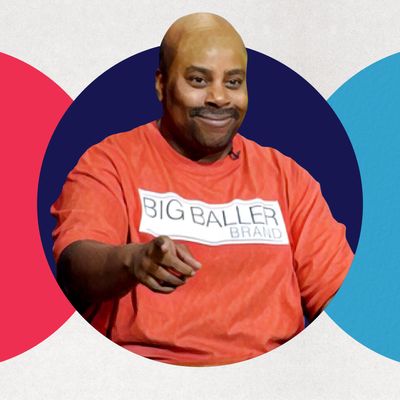
Kenan Thompson, who finally got nominated for an Emmy for Supporting Actor in a Comedy Series this past year, has impersonated more famous people, kinda famous people, and famous-for-a-day people than anyone in Saturday Night Live’s history. It’s partly that he is the show’s longest-running cast member, so he’s done a lot of things more than anyone else, but it’s largely because there’s not much on TV that can beat the joy of when Thompson really digs in an impression. You know ‘em, you love ‘em: Al Sharpton, David Ortiz, Steve Harvey, Charles Barkley, Jimmy McMillan. How does he do it?
This is the subject of this week’s episode of Good One, Vulture Comedy’s podcast about jokes and the people who write them. On it, Thompson and his longtime SNL collaborator Bryan Tucker discuss how they create someone like LaVar Ball, the dynamic, boastful father of three basketball-playing sons, including the Lakers’s Lonzo Ball.
Listen to the episode and read a short excerpt of the discussion below. Tune in to Good One every Monday on Apple Podcasts, Spotify, or wherever you listen.
Why LaVar Ball? Why then?
Kenan Thompson: It always happens because they happen. You know what I mean? People that pop and the audience is with it from point A, and I don’t have to sell them on the impression.
Bryan Tucker: He was all over the place that summer. I saw him on TV, and I remember texting you, “We gotta do this dude.”
KT: I was like, “Absolutely 1,000 percent. Tell me more about him.” I knew his dad was barking, but I wasn’t paying as much attention. Once I started seeing him on those off-ESPN shows where he actually got to talk, I was like, “Yeah, he’s fantastic.”
What was the initial thing that you saw that you were like, “Oh, this is Kenan”?
BT: The blustery arrogance. The energy. The time that he talked about how one-on-one he had never lost, and he said, “Neva lost.” And I was like, “Oh, that! Kenan can do that well.”
KT: Yeah, all day long. We love going after people that are just bigger than life in some sort of way, whether it’s in voice with Sharpton or if it’s in presence with Steve Harvey.
A lot of your characters have no self-consciousness whatsoever. There’s no part of him where he thinks, This is not what I should be saying.
KT: Totally, that makes for a great “Update.” Full-speed-ahead locomotive out of his mind.
BT: And will also kind of undercut himself as he says it — you know, will talk about the Big Baller lifestyle that his people are living, but, you know, “stay in a hotel with doors that open to the parking lot.”
KT: “310 rainy mornings.”
What’s the first step when tackling an impression like this?
BT: We had texted over the summer, and then I just wrote down a couple of jokes and lines. Then we sat down and Kenan gave his take on it. Then we just have fun throwing out stuff for about an hour, maybe 90 minutes.
KT: Bryan is like the chemist he is — he formulates it. It’s like, How do you get into the fun place where you wanna go? That’s the most important thing there is. If the setup’s not clear, they’re gonna miss the joke. We’ve learned that lesson painfully over the course of several different sketch ideas — like, just missing the whole setup or whatever. Once we do get everybody onboard and take them to a great place, it’s so much fun along the way because they see what we’re seeing.
Kenan, is an impression like this just like creating a character for you, but just with a singular jumping-off point?
KT: 1,000 percent. Doing the voice is only half of it, as far as getting to page eight on an idea. You know what I’m saying? You have to figure out what your take is on it.
BT: There are people who do impressions and are great at impressions, but often the best SNL impressions go up to that level of character. Dana Carvey was the best at that. And Kenan always brings his own thing to it.
KT: Like, yeah, he doesn’t mispronounce words, but that makes it fun for me.
BT: Exactly, you bring some Kenan flavor to it. Or you do that high voice.
KT: Yeah, that’s an exaggerated version of what he does. He, like, pitches up, like, [higher pitched] “When? When did I do this?” I thought, How can I notch that up by ten and get to, like, Bobby’s character Anthony Crispino?
Are “Weekend Update” bits easier to write?
KT: They’re much more straightforward. You’re just going after jokes as opposed to setting up a whole false reality. “Update” is more like a checklist, like, “Does this joke work?” “Does that joke work?” As opposed to “How can I make this make sense and get everybody onboard, and get laughs by page three?”
And I imagine it helps to have the “Weekend Update” anchor set it up like, “Basketball’s in the air …” or whatever.
KT: Exactly, exactly. I can just start firing.
BT: I thought the great thing that Chappelle’s Show did — that actually Chris Rock did a little bit, too — is they figure out the brilliant way of getting through the setup so you don’t have to start from a place where you don’t know what’s going on. Chappelle would say, “Y’all know there’s beer commercials where there happens to be no black people.”
KT: “Take a look at this!”
BT: SNL, unfortunately, we never had that. We have to start from zero, except for “Weekend Update” sometimes.
How much are you driven in your bigger-picture opinion of LaVar Ball? Like, there are only a couple more pointed parts of the first installment — when you say he’s a mix of Early Woods, Joe Jackson, and Dina Lohan. And when you have Colin Jost call him “Black Trump.”
KT: It’s just this depressive feeling that you get from listening to him. You feel like he’s smothering his son’s spotlight. Maybe, in the beginning, he helped talk his son into the league, but now it’s time for his son to show he can play. It’s not like he can’t play. I don’t know if he necessarily needs that loud of a cheerleader. It just seems like he’s stealing more of the attention for himself.
BT: And I think “Black Trump” was an observation we had talked about, but the rest of “Update” had a whole lot of Trump jokes. We were like, “Let’s not make this also that.” But it was kind of an observation. And now we’ve handed it off to Kanye West. He’s the Black Trump.
Your LaVar Ball premiered in the summer of 2017, during one of those “Weekend Update” summer specials. For that episode, but also in general, when the show is getting more attention than ever for political impressions, how do you approach the nonpolitical bits?
KT: Yeah, it’s easy for me because I only get political if I have somebody to impersonate. And I never sought out a David Clarke impression. When they throw me those kind of guys, I’ll just put in two seconds of what I hear from him or what I think of him and not put too much on it. I’ll just read it based on what they wrote. But when it’s organic and it’s somebody I really wanna do, I will sell it. But I just haven’t yet. For a while, there was just nobody to do except for Ben Carson or whatever. It was actually more of a pleasure for me because I could just still write toward the silly, as opposed to trying to watch CNN or Fox News all day long, and pick and pull from that stuff.


